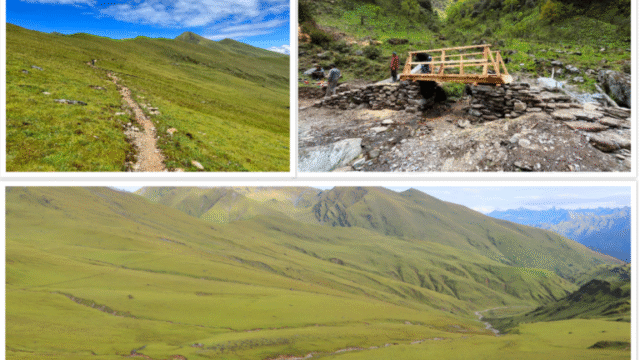Upper Mustang, often referred to as the “Last Forbidden Kingdom,” is a remote and isolated region in north-central Nepal. Nestled in the rain shadow of the Himalayas, it is an area of stark beauty, rich cultural heritage, and unparalleled trekking opportunities. Upper Mustang has become a sought-after destination for adventure seekers and cultural enthusiasts alike, drawn by its unique landscape, ancient monasteries, and the allure of its mysterious past.
Upper Mustang lies in the northern part of Nepal, bordering Tibet. The region is characterized by its rugged terrain, deep gorges, and stark desert-like landscape. The Kali Gandaki River, one of the world’s deepest river gorges, runs through this area, adding to its dramatic topography. The climate in Upper Mustang is distinct from the rest of Nepal, with very little rainfall due to its position in the rain shadow of the Annapurna and Dhaulagiri ranges. This makes it an ideal destination for trekking, especially during the monsoon season when other parts of Nepal are experiencing heavy rains.
The history of the Upper Mustang is deeply intertwined with Tibetan culture. The region was once part of the Tibetan empire and later became an independent kingdom. It was only in the 18th century that it became part of Nepal. The influence of Tibetan Buddhism is evident in the numerous monasteries, chortens, and mani walls that dot the landscape. The walled city of Lo Manthang, the capital of the former Kingdom of Lo, is a UNESCO World Heritage site and a major highlight for visitors. The city’s ancient palaces, monasteries, and narrow alleyways offer a glimpse into a way of life that has remained largely unchanged for centuries.
Trekking in Upper Mustang is a unique experience, offering a blend of cultural immersion and natural beauty. The journey begins in the town of Jomsom, accessible by a short flight from Pokhara. From Jomsom, trekkers make their way through picturesque villages, barren landscapes, and high-altitude passes. The trail offers stunning views of the Nilgiri, Annapurna, and Dhaulagiri ranges.
The highlight of the trek is reaching Lo Manthang, where visitors can explore the ancient city, visit monasteries such as Thubchen and Jampa, and interact with the local people, known as Loba. The hospitality of the Loba people is legendary, and their unique customs and traditions provide a rich cultural experience.
One of the most vibrant cultural events in Upper Mustang is the Tiji Festival, held annually in Lo Manthang. The three-day festival, usually held in May, celebrates the victory of good over evil and involves elaborate rituals, dances, and performances by monks. The festival attracts both locals and tourists, offering a unique opportunity to witness the cultural richness of the region.
While trekking is the primary attraction in Upper Mustang, the region offers other adventure activities as well. Mountain biking has become increasingly popular, with several trails providing thrilling rides through rugged landscapes. The Mustang region is also ideal for off-road jeep tours, offering a different perspective of the terrain and allowing access to remote areas that are difficult to reach on foot.
The increasing popularity of Upper Mustang as a tourist destination has brought both opportunities and challenges. The local government and various organizations are working towards promoting sustainable tourism practices to preserve the fragile environment and cultural heritage of the region. Efforts are being made to involve the local communities in tourism activities, ensuring that they benefit economically while maintaining their traditional way of life.
The Annapurna Conservation Area Project (ACAP) plays a crucial role in managing tourism and conservation efforts in the region. ACAP focuses on biodiversity conservation, sustainable tourism, and improving the livelihoods of local communities through various initiatives. Trekkers are required to obtain special permits to enter Upper Mustang, which helps regulate the number of visitors and generate revenue for conservation efforts.
Traveling to the Upper Mustang requires careful planning and preparation. Here are some essential tips for prospective visitors:
- Permits: Upper Mustang is a restricted area, and trekkers need to obtain a special permit from the Department of Immigration in Kathmandu or Pokhara. The permit fee is relatively high, which helps control the number of visitors and support conservation efforts.
- Best Time to Visit: The best time to visit the Upper Mustang is from late March to early November. The monsoon season (June to August) is particularly favorable as the region lies in the rain shadow and experiences minimal rainfall.
- Accommodation: While trekking in the Upper Mustang, accommodation options are limited to tea houses and lodges. These are basic but comfortable, offering a place to rest and enjoy local hospitality. It is advisable to book in advance, especially during peak trekking seasons.
- Health and Safety: Trekkers should be prepared for high-altitude conditions and ensure they have adequate travel insurance. It is essential to acclimatize properly to avoid altitude sickness. Carrying a basic first aid kit and necessary medications is recommended.
- Responsible Tourism: Respect the local culture and traditions, minimize waste, and follow guidelines set by conservation authorities. Hiring local guides and porters not only enhances the trekking experience but also supports the local economy.
Upper Mustang is a destination that offers an extraordinary blend of natural beauty, rich cultural heritage, and adventure. Its unique landscape, historical significance, and vibrant traditions make it a must-visit for those seeking an off-the-beaten-path experience in Nepal. As tourism continues to grow in the region, it is crucial to promote sustainable practices to preserve the pristine environment and cultural integrity of Upper Mustang. By doing so, travelers can enjoy the wonders of this hidden gem while ensuring its preservation for future generations.






